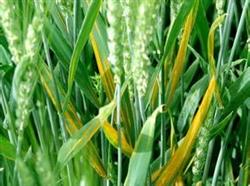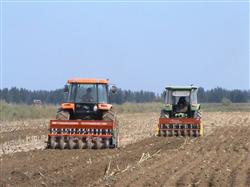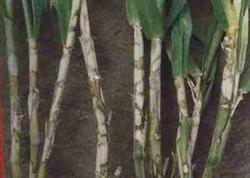The control of wheat diseases, insect pests and weeds in spring is the key.

With the warming of the climate, wheat has gradually entered the stages of turning green, getting up and jointing, which is not only an important period for wheat to promote the growth of weak seedlings, control and steady growth, but also the key stage for the prevention and control of wheat diseases and insect pests. In view of the occurrence characteristics and existing problems of wheat diseases, pests and weeds this year, this reporter recently interviewed Professor Wang Baotong, School of Plant Protection, Northwest University of Agriculture and Forestry Science and Technology. Professor Wang provided some methods for farmers on how to do a good job in the prevention and control of wheat diseases, pests and weeds in spring to ensure a good wheat harvest. Control weeds in wheat fields in spring. No chemical control was carried out last winter and serious weeds occurred in the field, so the control should be carried out in spring. Due to the spring wheat turning green, the suitable time for chemical removal is relatively tight, and the temperature is unstable, improper use of herbicides is prone to drug damage. Therefore, we must pay attention to the following points: the time of ① spraying must be controlled from wheat turning green to jointing, the daily average temperature is stable above 10 degrees, and chemical herbicides should not be used after wheat jointing to prevent drug damage. Pay attention to the weather change before ② application. When there is a strong cooling within 2-4 days before application, it is not suitable to use the drug. The dosage of ③ should be strictly controlled and should not be increased or decreased at will. Some new herbicides should not be used blindly. ④ spray should be uniform and thoughtful, do not leak spray, do not re-spray. ⑤ chooses the correct herbicide type according to the weed species in the field. Field control of diseases and insect pests in spring. Wheat turning green to jointing stage is not only the time when wheat diseases and insect pests begin to occur and harm, but also the key period of pest control. Therefore, it is necessary to make a good forecast, determine the best control period according to the occurrence of diseases and insect pests in the field, select good varieties of pesticides, and take unified control against airborne diseases and migratory pests such as wheat stripe rust, powdery mildew, aphids and so on. For local diseases such as wheat total erosion disease and cyst nematode, measures should be taken to control the spread to avoid the spread of man-made and harvester to non-epidemic areas and slow down the spread rate. ① wheat rust, powdery mildew and leaf blight: these epidemic diseases must be investigated and observed regularly. Before wheat heading, the diseased plant rate of wheat powdery mildew is 15% or the diseased leaf rate is 5%, the diseased leaf rate of wheat stripe rust is 0.51%, the diseased leaf rate of wheat leaf rust is 5%, and the diseased leaf rate of wheat leaf blight is 1%. As long as any of the above diseases reach the control target, control should be carried out immediately. ② wheat sheath blight: turning green and jointing stage is the peak period of occurrence and development of wheat sheath blight. In the early and middle of March, when the rate of diseased plants in the field reaches 10%, it should be controlled as soon as possible. ③ wheat midge: spread poison soil before April 20 to control the pupa stage. The effect of controlling wheat trematode in pupa stage is the best, which can directly kill some pupae and larvae rising to the soil, and also inhibit adults. ④ wheat red spider: when the line is 200 heads per mu, spray 1.8% mu with 8 ml of mites and 50 kg of water or 15% clean acarine EC 2000 × 3000 times. ⑤ wheat aphid: wheat jointing stage lowers the source base of aphids. When there are more than 500 aphids per 100 wheat plants, or when the rate of aphids is more than 25%, the mu is sprayed with 50 ml of 25% aphid whey, 20% imidacloprid 2500 times or 25% aldicarb 3000 times.
- Prev

Analysis of current Wheat Seedling situation and suggestions on Spring Management
The key to a bumper grain harvest is to improve the quality of sowing with seven-minute planting and three-part management. At present, spring wheat in our province is about to enter the sowing period, how to make a good sowing pass and improve the sowing quality is related to the overall situation of spring wheat harvest throughout the year. First, the selection of improved varieties to win high wheat yield, soil is the foundation, fertilizer is nutrition, water is the lifeline.
- Next

Beware of wheat sheath blight in spring
Wheat sheath blight is a kind of fungal disease which is mainly transmitted by soil. With the improvement of the level of yield, the harm of the popularization of high-yield varieties and the management of wheat field with large water and fertilizer is becoming more and more serious. After wheat sowing, if the germ is infected during germination, the coleoptile becomes brown, it will rot and die; the diseased plant will be clear after jointing.
Related
- The first cup of black tea in spring, the flavor and history of tea gardens in Kenya, Africa
- The computer can not only choose potatoes, but also grow tea rice. AI will grow winter oolong tea champion.
- It is not only the inflated tea bitten by insects, but also engraved with the four seasons tea in Beipu.
- The Oriental Beauty Tea Festival in Zhuxian County takes the stage at the weekend to experience the plus-size feast of oil tea.
- & quot; Oriental Beauty Tea & Exploration of Emei in Hsinchu, the hometown of quot;
- The new variety of strawberry "Tainong 1" dessert is the first choice with mellow aroma. Crimson gorgeous
- History of Tea in Taiwan: from Wild Inner Mountain to Export Tea Garden
- Two types of Taiwan Oriental Beauty Black Tea won the British three-Star Award for Childhood Tea Xiang Zhang Jiaqi changed from pilot to champion tea maker.
- Banana species and varieties: the planting history of Taiwan Xianren banana and dwarf banana is long, is banana disease resistant?
- Coffee planting Technology: Qianjie Coffee from Seedling to harvesting

